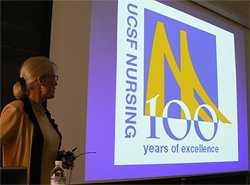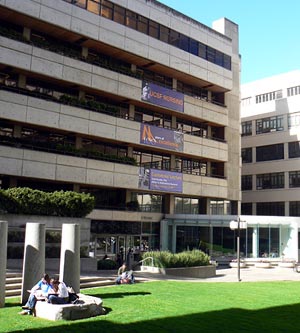
Chief among the challenges facing the UCSF School of Nursing are planning for a surge in student enrollment and preparing for succession as one-third of the school's faculty nears retirement, Dean Kathleen Dracup said.
Preparing for future student enrollment growth and succession of faculty also presents opportunities for the school, which is celebrating its centennial anniversary.
"As we think about this enrollment growth, it gives the School of Nursing an opportunity to envision where we see health care moving 30 years from now," Dracup, RN, DNSc, said in her annual state of the school address on Feb. 16.
UC enrollment recommendations are to raise enrollment by 50 percent for master's nursing students and by 100 percent for doctoral nursing students, both by 2010, according to the January 2007 final report of the UC Advisory Council on Future Growth in the Health Professions.
The school has named a 16-member task force, chaired by Carmen Portillo, RN, PhD, a professor in the Department of Community Health Systems, to come up with a plan to handle enrollment growth.
The nursing school, which received state funding for enrollment growth last year, now serves 637 students, and may add 50 more this fall if the state Legislature approves additional funding, Dracup said. "We are in a period of incredible growth."
The need to educate and train nurses is critical, since California ranks 50th in the nation in the number of registered nurses per capita. With an aging population requiring more care, the state projects a shortfall of 116,600 nurses by 2020, Dracup explained. A major hurdle to enrolling more nursing students is the statewide shortage of faculty among all public and private nursing programs. At UCSF, the problem is compounded by an aging faculty: 37 percent of the nursing faculty is aged 60 or older.
"A lot of people in the School of Nursing are between the ages of 55 and 60," Dracup said. "Over one-third may retire in the next five years. We need to be mindful not only of enrollment growth, but how we are going to recruit faculty."
The lack of space on campus to accommodate growth in educational and research programs continues to be a problem, she noted. Dracup is looking forward to the outcome of the campuswide strategic planning process, which will determine academic priorities. In addition, UCSF leaders are expected to participate in a retreat this spring to address campuswide space needs.
Among other highlights mentioned in Dracup's address, the nursing school:
- ranks No. 1 in funding received from
the National Institutes of Health (NIH), achieving a 50 percent increase in
the past five years;
- works with the other schools in developing
the Clinical and Translational Science Institute (CTSI), which is enhancing
interdisciplinary work across labs and into clinical settings and the community;
and
- continues to boost the number of underrepresented
minority students, including raising the percentage of those enrolled in the
Master's Entry Program in Nursing (MEPN) from 18 percent in 2005 to 47 percent
in 2007.

UCSF School of Nursing Dean Kathleen Dracup delivers her state of the school address.
Making Progress
Dracup emphasized the importance of the CTSI, UCSF's NIH-funded program that aims to lower barriers between schools and disciplines and to encourage creative and innovative approaches to solving complex health problems. While the concept of translational research has long been described as bridging research at the bench and bedside treatment, Dracup described the CTSI's efforts as going further - "from neuron to neighborhood."
"The potential for the CTSI is culture-changing, and it goes hand in hand with the movement toward increasing interprofessional, interdisciplinary education on this campus," she said.
Dracup reviewed progress on achieving her top three priorities over the past year: emphasizing the teaching mission, strengthening the infrastructure to support research activities and increasing diversity at UCSF.
She credited Judy Martin-Holland, RN, PhD, dean of academic services and diversity enhancement, for leading the school's efforts in increasing the numbers of underrepresented minority students. While progress has been made, as noted above for the MEPN students, more must be done to diversify the student body, Dracup said. "We are really concerned about representing the diversity we see in our patients and in the state of California in our classrooms," she said.
Dracup thanked Harvey Brody, DDS, UCSF faculty ambassador, for his help in broadening the search for faculty members. She set a goal to double the number of underrepresented minorities in the faculty by 2010. Today, 20 percent of the nursing school faculty, which numbers 155, is underrepresented minorities, up from 15.9 percent among 126 faculty members in 2005.
Enhancing Teaching
In working to enhance the teaching mission, the school had to determine whether it should start a professional doctorate nursing program (DNP). Last September, 89 of the 125 faculty members voted 72 percent to 28 percent not to embark on the DNP at UCSF. Instead, Dracup says, the school will continue to monitor the national scene and will focus on revising the master's curriculum with the help of consultants.
Dracup also says she will continue to look for ways to boost financial aid for students, who are requiring more loans and sinking deeper in debt as professional school fees rise. "That's my No. 1 priority for philanthropy. We have to continue to focus on doctoral students."

Students enjoy a sunny day in Saunders Court outside the School of Nursing building.
The school has made great progress in garnering loans, grants and awards for nursing students. When Dracup took the helm of the nursing school in 2001, it offered very little financial aid assistance to PhD students, except for international students. With the help of the Gordon and Betty Moore Foundation, the school now offers more than $2.5 million in total financial aid funds awarded to nursing students.
The nursing school also has developed and greatly expanded its innovative web-supported curriculum, offering 172 courses with some component of web-based instruction today. In fact, nine midwifery courses are now part of the web curriculum and online testing is increasing, Dracup noted. Still, the school is experiencing a classroom shortage, since most classes use a combination of face-to-face instruction and the web.
Dracup also reported that the school is looking at ways to reward excellence in teaching in part by establishing an award that parallels in prominence the Helen Nahm Research Lecture Award. The deadline to nominate an educator for this new award is mid-April, Dracup said, adding that Janice Humphreys, RN, PhD, an associate professor in the Department of Family Health Care Nursing, is chairing the selection committee.
The school also will begin offering four new schoolwide awards to recognize top teachers and is exploring with the UCSF School of Medicine the possibility of broadening the Haile T. Debas Academy of Medical Educators to include faculty from other schools.
Photos/Lisa Cisneros
Related Links:
UCSF Nursing Centennial


